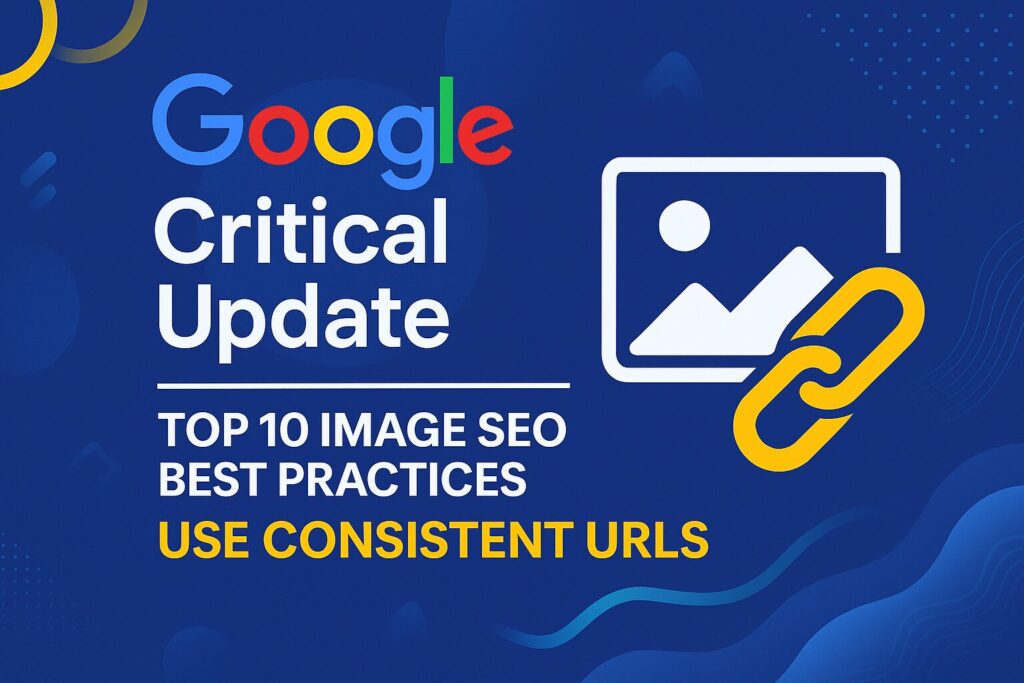
Introduction to Google’s Image SEO Update
In May 2025, Google revised its image SEO best practices, emphasizing the importance of using consistent URLs for images across websites. This update aims to enhance crawl efficiency and ensure better indexing of images, especially on larger websites.
Understanding Crawl Budget and Its Importance
Crawl budget refers to the number of pages Googlebot crawls and indexes on a website within a given timeframe. Efficient use of this budget is crucial for large websites to ensure that all important pages and resources are indexed.
The Significance of Consistent Image URLs
Using the same URL for identical images across multiple pages allows Google to cache and reuse the image without multiple requests. This practice conserves crawl budget and enhances indexing efficiency.
Implementing Consistent Image URLs Across Your Website
To align with Google’s recommendations:
- Audit Current Image URLs: Identify instances where the same image is hosted under different URLs.
- Standardize Image Storage: Store images in a centralized location with a consistent naming convention.
- Update Website Templates: Ensure that templates reference images using standardized URLs.
- Monitor Changes: Use tools like Google Search Console to monitor the impact of these changes on crawl stats.
Technical Strategies for Image URL Consistency
- Centralized Image Management: Utilize a content delivery network (CDN) or a centralized media library to manage images.
- Consistent Naming Conventions: Adopt a clear and consistent naming strategy for image files.
- Avoid Duplicate Uploads: Prevent uploading the same image multiple times under different names or directories.
Common Mistakes in Image URL Management
- Multiple URLs for the Same Image: Hosting the same image under different URLs can waste crawl budget.
- Inconsistent Naming: Using different names for the same image can confuse search engines.
- Lack of Centralization: Disorganized image storage can lead to inconsistencies and inefficiencies.
Tools to Monitor and Audit Image URLs
- Google Search Console: Monitor crawl stats and identify issues related to image indexing.
- Screaming Frog SEO Spider: Crawl your website to identify duplicate images and inconsistent URLs.
- Sitebulb: Analyze your website’s structure and identify image-related SEO issues.
Case Studies: Impact of Consistent Image URLs on SEO
Implementing consistent image URLs has shown positive impacts on SEO performance. Websites that adopted this practice observed:
- Improved Crawl Efficiency: Reduced redundant crawling of identical images.
- Enhanced Indexing: Better indexing of images, leading to increased visibility in image search results.
- Optimized Resource Usage: Efficient use of server resources and reduced bandwidth consumption.
Integrating Image SEO with Overall SEO Strategy
Image SEO should be an integral part of your overall SEO strategy. Ensure that:
- Alt Text is Descriptive: Provide meaningful alt text for images to enhance accessibility and SEO.
- Images are Optimized for Speed: Compress images to improve page load times.
- Structured Data is Implemented: Use schema markup to provide additional context about images.
Conclusion: Embracing Google’s Image SEO Best Practices
Adopting consistent image URLs across your website is a crucial step in optimizing your site’s SEO performance. By aligning with Google’s updated best practices, you can enhance crawl efficiency, improve image indexing, and provide a better user experience.
FAQs on Google’s Image SEO Update
Q1: Why is using consistent image URLs important for SEO?
A1: Consistent image URLs allow Google to cache and reuse images efficiently, conserving crawl budget and enhancing indexing.
Q2: How can I identify duplicate image URLs on my website?
A2: Use tools like Screaming Frog SEO Spider or Sitebulb to crawl your website and identify duplicate images.
Q3: Does this update affect small websites?
A3: While the impact is more significant for larger websites, small websites can also benefit from improved crawl efficiency.
Q4: Should I update existing image URLs to be consistent?
A4: Yes, updating existing image URLs to be consistent can improve crawl efficiency and SEO performance.
Q5: How does this update relate to image alt text?
A5: While the update focuses on URL consistency, maintaining descriptive alt text remains essential for accessibility and SEO.
Q6: Can inconsistent image URLs lead to duplicate content issues?
A6: Yes, hosting the same image under different URLs can be perceived as duplicate content, potentially impacting SEO.
